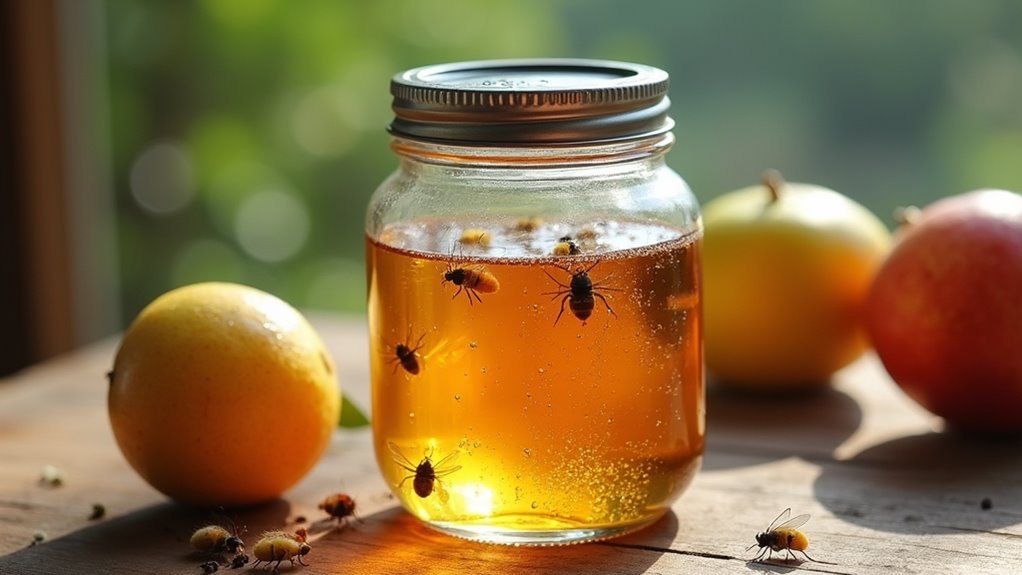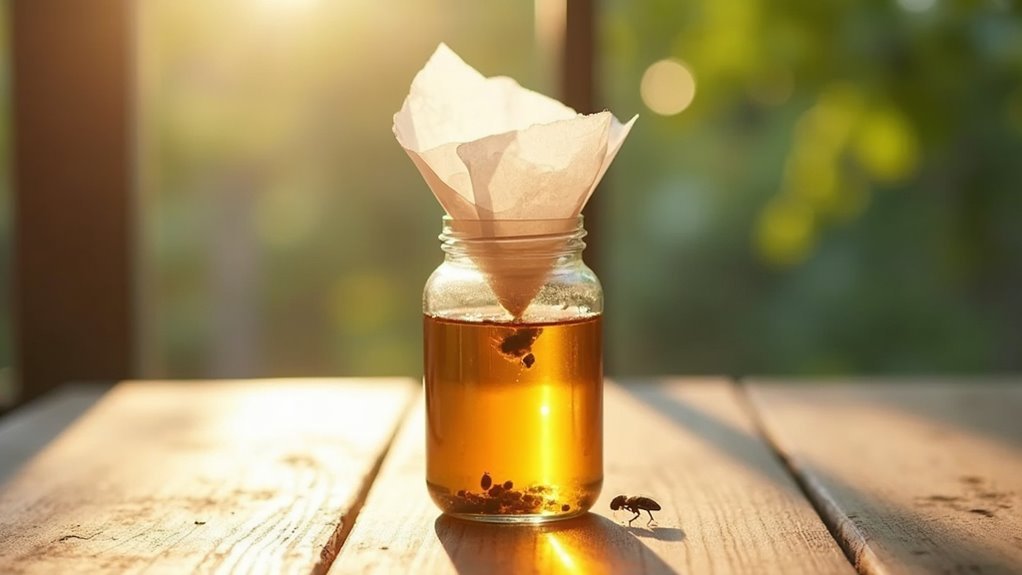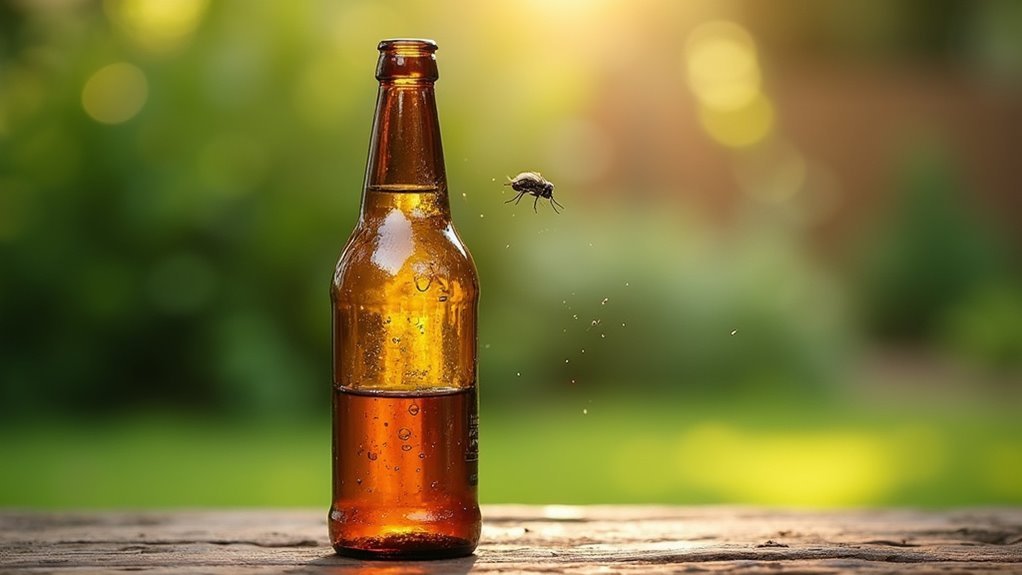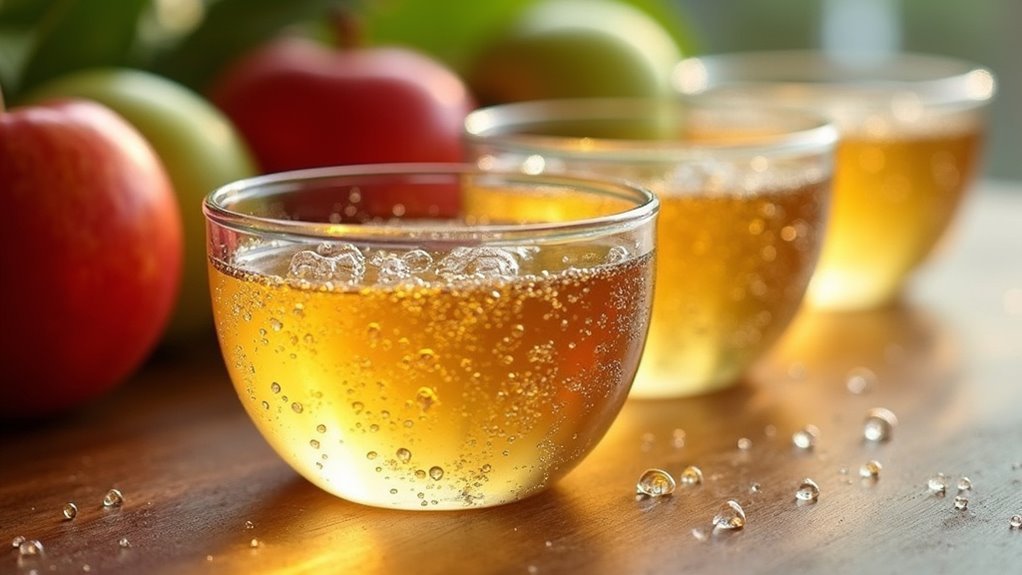You can create effective fruit fly traps using apple cider vinegar and dish soap in various containers like mason jars, wine bottles, or shallow dishes. The most successful methods include covering containers with perforated plastic wrap, creating paper cone funnels, or inverting bottle tops to prevent escape. Add several drops of dish soap to break surface tension and drown flies. Place traps near fruit bowls or garbage areas where flies congregate for maximum effectiveness. These simple techniques will help you master complete fruit fly elimination.
Classic Mason Jar Trap With Perforated Lid

When fruit flies invade your kitchen, the classic Mason jar trap with a perforated lid becomes your most reliable weapon against these persistent pests.
You’ll need apple cider vinegar as your primary attractant, which effectively lures flies into the jar. Simply fill your Mason jar with vinegar, then cover it with a lid containing small holes.
Apple cider vinegar serves as the perfect bait – fill your Mason jar and add a perforated lid for instant results.
The perforated lid design creates the perfect trap mechanism – flies can easily enter through the holes but can’t escape once inside.
You’ll want to place this trap near areas where you’ve spotted fruit flies congregating. The clear jar allows you to monitor its effectiveness visually, often capturing at least 50 flies.
Unlike other methods, this trap provides excellent airflow while ensuring trapped flies remain contained, delivering superior results.
Wine Bottle Funnel Trap Method
You’ll need an empty wine bottle and the same vinegar-soap mixture to create this stylish yet functional trap.
Start by pouring apple cider vinegar into the bottle, adding a drop of dish soap, then insert a paper funnel or crumpled paper into the neck to create a one-way entry point.
Place your completed trap on countertops near fruit bowls or garbage areas where you’ve spotted the most fly activity.
Wine Bottle Preparation Steps
Since creating an effective wine bottle funnel trap requires precise preparation, start by pouring a small amount of apple cider vinegar into an empty wine bottle to serve as your primary bait. The vinegar’s scent will attract fruit flies into your DIY fruit fly trap.
Here’s your step-by-step preparation process:
- Roll a piece of paper into a cone shape that fits snugly into the bottle’s neck, ensuring the opening allows flies to enter but prevents escape.
- Insert the paper cone with the larger end exposed outside the bottle.
- Apply a thin layer of dish soap inside the bottle neck to break surface tension.
- Position your completed trap near areas where you’ve noticed fruit fly activity.
This simple preparation creates an effective entry system that traps flies once they’re drawn to the vinegar.
Funnel Creation Technique
Creating the perfect funnel requires repurposing a plastic bottle to form an inverted entry system. Cut the top third off a plastic bottle, then flip this piece upside down and insert it into the bottom portion.
The funnel creation technique guarantees the opening is narrow enough to entice fruit flies while remaining wide enough for easy access.
Pour apple cider vinegar into the bottle’s bottom as your primary attractant. Add one drop of dish soap to break the surface tension, ensuring flies drown upon contact.
Position your completed trap near ripening fruits or garbage where fruit flies congregate. This strategic placement maximizes trapping effectiveness by targeting their preferred gathering spots.
Trap Placement Strategy
The wine bottle funnel trap method transforms an ordinary wine bottle into an effective fruit fly catcher through strategic positioning and proper setup. Your trap placement strategy directly impacts how many fruit flies you’ll capture. Pour apple cider vinegar into the bottle’s bottom – this scent acts as a powerful attractant that draws fruit flies toward the narrow opening.
For best results, position your trap strategically:
- Place near ripening fruits where fruit flies congregate most frequently
- Position on countertops close to problem areas but away from food preparation zones
- Confirm the bottle’s narrow opening faces the main flight paths of fruit flies
- Consider multiple trap locations if you’re dealing with widespread infestations
While this method typically captures 4-5 flies and may appear obtrusive, proper placement maximizes effectiveness and helps control fruit fly populations efficiently.
Plastic Wrap Coverage Technique With Punctured Holes
Why do so many homeowners swear by the plastic wrap coverage technique for eliminating fruit flies? This method’s effectiveness lies in its simple yet ingenious design.
You’ll start by pouring apple cider vinegar into a jar, then tightly covering the opening with plastic wrap. Next, poke small holes in the plastic wrap using a toothpick or needle. These openings allow fruit flies to enter while preventing their escape.
Here’s the game-changer: add a drop of dish soap to your vinegar. This reduces surface tension, causing flies to drown immediately upon contact with the liquid.
When tested against other DIY traps, this setup consistently catches 8-10 fruit flies per trap. You’ll appreciate how accessible the materials are and how quickly you can assemble this non-toxic solution.
Paper Cone Jar Trap Design

While plastic wrap traps excel at preventing escapes through their secure seal, paper cone jar traps offer a different approach that’s equally simple to construct.
Paper cone jar traps provide an effective alternative to plastic wrap methods while maintaining the same straightforward construction process.
You’ll roll a sheet of paper into a cone shape and insert it into a jar filled with apple cider vinegar. The vinegar serves as irresistible bait, drawing fruit flies through the cone’s narrow opening.
This trap design offers several advantages:
- Budget-friendly construction using common household items
- Visually appealing setup that won’t detract from your kitchen
- Easy entry point for flies through the cone opening
- Narrow escape route that prevents flies from leaving
However, creating the perfect paper cone can be tricky, and test results show this method typically catches fewer flies than other designs.
Wide-Mouth Container With Soap Solution
You’ll find the wide-mouth container method remarkably simple to set up and highly effective at eliminating fruit flies from your kitchen.
Start by pouring half a cup of apple cider vinegar into a jar or bowl, then add several drops of dish soap to break the surface tension.
This straightforward trap delivers impressive results as the vinegar attracts flies while the soap guarantees they can’t escape once they land.
Setup and Preparation
Creating a wide-mouth container trap requires just three simple materials and takes less than five minutes to assemble.
You’ll need apple cider vinegar, liquid dish soap, and plastic wrap to build this effective solution.
Follow these straightforward steps to set up your trap:
- Pour 1/2 cup of apple cider vinegar into your wide-mouth container to create the attractant base.
- Add several drops of liquid dish soap to break the surface tension and make sure flies can’t escape.
- Stretch plastic wrap tightly over the container’s opening to seal it completely.
- Use a toothpick to poke small entry holes in the wrap.
Position your finished trap near fruit bowls, garbage areas, or anywhere you’ve spotted fruit fly activity for maximum effectiveness.
Effectiveness and Results
Once you’ve assembled your wide-mouth container trap, you’ll be amazed by its performance. This vinegar-based solution demonstrates exceptional effectiveness, capturing at least 50 fruit flies in testing scenarios.
The apple cider vinegar acts as irresistible bait, drawing flies directly into your trap, while the dish soap eliminates surface tension and guarantees they can’t escape by drowning them quickly.
You’ll appreciate the trap’s perfect effectiveness score of 10 out of 10, markedly outperforming alternative methods. The wide-mouth design allows you to easily monitor your catch and dispose of captured flies without creating mess.
Adding small holes to the container lid prevents any escapes, maximizing efficiency. You can expect consistent results with minimal effort required for maintenance.
Beer Bottle Modification Trap

When you’re looking for a trap that’s both effective and easy to construct, the beer bottle modification combines household materials into a powerful fruit fly catcher.
This vinegar-based trap works by exploiting fruit flies’ attraction to fermented scents while using smart design to prevent their escape.
Here’s how you’ll build this effective trap:
- Pour apple cider vinegar into an empty beer bottle’s bottom
- Cut paper into a funnel shape with an opening large enough for flies to enter
- Insert the funnel snugly into the bottle’s neck, eliminating escape gaps
- Position the completed trap near fruit fly activity areas
The vinegar’s sweet scent draws fruit flies inside, while the funnel creates a one-way entry system.
Once trapped, the flies can’t navigate back through the narrow funnel opening, making this modification highly effective.
Shallow Dish Vinegar and Soap Combination
Among the simplest and most effective fruit fly traps you can make, the shallow dish vinegar and soap combination requires only two common household ingredients.
Fill a small bowl with apple cider vinegar and add several drops of dish soap. The vinegar’s sweet scent attracts fruit flies, while the dish soap breaks surface tension, causing them to drown upon contact.
Position your shallow dish near problem areas like ripe fruits or garbage bins where flies congregate. This strategic placement maximizes your trap’s effectiveness.
The vinegar and dish soap mixture will trap (and kill!) fruit flies that land on the surface, preventing their escape.
Check your trap regularly and refresh the mixture to maintain peak performance. This accessible DIY solution effectively controls fruit fly populations with minimal effort.
Double-Layer Plastic Wrap Trap
Several fruit fly enthusiasts swear by the double-layer plastic wrap trap for its superior catching power and escape-proof design. This method uses a jar filled with apple cider vinegar mixed with dish soap, then covered tightly with plastic wrap.
Here’s what makes this trap so effective:
- Small holes in the plastic wrap let fruit flies enter but prevent escape
- The dish soap creates surface tension that drowns flies instantly
- Apple cider vinegar’s strong scent acts as an irresistible lure
- The tight seal maximizes trapping efficiency compared to open dishes
You’ll catch dozens of fruit flies with this simple setup.
Position your double-layer plastic wrap trap near ripe fruits or garbage disposal areas where flies congregate most. The combination works because flies can’t resist the vinegar’s aroma but can’t escape once inside.
Inverted Bottle Top Method
One ingenious trap design transforms any plastic bottle into a highly effective fruit fly catcher through the inverted bottle top method.
You’ll cut off the bottle’s top portion and flip it upside-down into the bottom section, creating a funnel entrance that traps flies inside. Fill the bottom with apple cider vinegar, which attracts fruit flies with its potent scent.
Add several drops of dish soap to reduce surface tension, preventing trapped flies from escaping by floating. Position your trap near ripening fruits or other problem areas for maximum results.
This eco-friendly solution repurposes waste plastic while avoiding harmful pesticides, making it both cost-effective and environmentally responsible for your home.
Large Opening Container With Essential Oil Enhancement
If you’re seeking maximum trapping capacity with enhanced attractant power, a large opening container with essential oil enhancement delivers exceptional results for persistent fruit fly problems.
This method combines the proven effectiveness of apple cider vinegar with aromatic essential oils to create an irresistible trap. The wide-mouth design provides easy access for flies while accommodating larger volumes of bait and trapped insects.
Here’s what makes this approach superior:
- Mix 1/2 cup apple cider vinegar with dish soap and 3-4 drops of peppermint or eucalyptus essential oils
- Use wide-mouth jars or large bowls for maximum accessibility
- Position containers near fruit bowls or problem areas
- Replace contents less frequently due to increased capacity
The essential oils mask competing odors while the large opening container guarantees you’ll catch more flies with each setup.
Frequently Asked Questions
How to Make a Fruit Fly Trap With Vinegar and Dish Soap?
You’ll pour half a cup of apple cider vinegar into a jar, add a drop of dish soap, cover with plastic wrap, poke small holes, and place near fruit.
What Is the Best Liquid for a Fruit Fly Trap?
You’ll find apple cider vinegar works best for fruit fly traps. Its fruity, fermented scent naturally attracts flies. Wine and beer also work well due to their alcohol content and fermentation properties.
Does Vinegar and Soap Kill Flies?
Vinegar and soap don’t directly kill flies through poison. Instead, you’ll find the soap reduces surface tension, causing flies to drown when they land on the vinegar mixture after being attracted.
Can I Use White Vinegar Instead of Apple Cider Vinegar for Flies?
You can use white vinegar instead of apple cider vinegar for fruit flies, but it’s less effective. Add sugar or fruit juice to boost its attractiveness, and you’ll likely need more experimentation.
In Summary
You’ve now got nine proven methods to eliminate fruit flies using simple household items like vinegar and soap. Choose the trap that works best with materials you have on hand, whether it’s a mason jar, wine bottle, or shallow dish. Remember to place your traps near problem areas like fruit bowls and garbage cans. With consistent use, you’ll notice fewer fruit flies within days and complete elimination within a week.





Leave a Reply